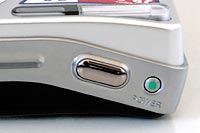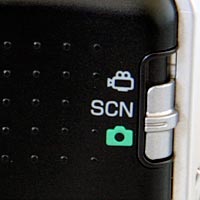Ricoh Caplio R5 Review
Review Date: September 22nd 2006
Leave a comment about this Review
|
Ease of Use
The Ricoh Caplio R5 is a very compact digital camera that easily fits in the palm of your hand, and it is also light at around 140g, principally because of its all-plastic construction. This is one camera that you truly won't notice carrying in a trouser/shirt pocket or a handbag. It has an under-stated appearance that is fairly attractive, but which isn't going to really impress anyone either. A sticker on front of my review sample proudly proclaims that the Ricoh Caplio R5 has a 28-200mm zoom range, a truly amazing feat of engineering in such a small camera. When the lens is fully extended, the camera measures over 7cm in depth, but thankfully it retracts fully back into the camera when it is turned off.
One curious design element which I don't understand is a gradual 15 degree bend in the camera body on the right hand side (looking from the back). I'm not really sure why Ricoh have done this, other than to prevent the R5 from being too box-like and boring in shape. Consequently the corner of the small flash unit protrudes quite a lot from the front of the camera, much more than on the older Ricoh R4. Most aspects of our sample unit were generally well-built. The only questionable design aspects are the AV-Out and USB ports on the side of the camera, which are completely unprotected by a flap or cover, and the flimsy battery/memory card cover. The Power button is much too small - we preferred the larger version on the R4 - and even more importantly the zoom lever has also been shrunk, making it quite awkward to use in a hurry.
The Ricoh Caplio R5 is a point and shoot camera with no advanced exposure controls, so it's not particularly complex in terms of its design. There are 10 external controls in total, leaving plenty of room for the large 2.5 inch LCD screen that dominates the back of the camera. The R5 follows the design of previous Ricoh cameras by having a vertical row of buttons on the rear, to the right of the LCD, along with the zoom lever and the navigation pad. One of these vertical buttons is the Adj. button, a particularly nice feature that allows you to quickly adjust 2 different settings that are commonly used. Press it once and you can alter exposure compensation; press it again and you can change the White Balance setting. Even better, the Adj. menu is customisable - you can add two more settings to it and also choose what those settings are, allowing you to control exactly what you want quick access to. I added ISO speed and metering mode.
| Shutter Release / Power Buttons | Movie / Scene Mode / Camera Switch |
 |
 |
There is one innovative feature on the Ricoh Caplio R5 that aims to make life easier for you. This camera has an anti-shake system, dubbed Vibration Correction - turn it on and the Ricoh Caplio R5 automatically compensates for camera shake, which is a slight blurring of the image that typically occurs at slow shutter speeds. You don't notice that the camera is actually doing anything different when anti-shake is turned on, just that you can use slower shutter speeds than normal and still take sharp photos. Ricoh seem to have realised the importance of this system, as it is turned on by default and there is no longer an external button to control it, as there was on the Caplio R4 (there's now a Camera Shake Correction menu option instead).
However, what Ricoh gives you in the form of an effective anti-shake system, it takes away by providing a limited usable ISO range of 64-200, as the faster ISO speeds all exhibit high levels of noise (see the Image Quality page). This essentially means that you really need to leave the anti-shake system turned on all the time to compensate for the slow shutter speeds, which kind of negates any real advantages that the anti-shake system offers. Thankfully leaving the anti-shake system on didn't negatively affect the battery-life, with the camera managing over 350 shots before the battery needed to be recharged (quite an improvement on the older Ricoh R4, which managed around 250 shots).
If you have never used a digital camera before, or you're upgrading from a more basic model, reading the comprehensive and easy-to-follow manual before you start is a must. Thankfully Ricoh have chosen to supply it in printed format, rather than as a PDF on a CD, so you can also carry it with you. The large 2.5 inch LCD screen is the only way of framing your shots, so if you have to have an optical viewfinder, look elsewhere now. Ricoh have once again increased the resolution of the LCD screen on the R5, which now has 230,000 pixels (compared to the previous models 153,000 pixels), which is a definite improvement on the the R4. The various icons used to represent the camera settings are clear and legible, although I was slightly annoyed by the LCD brightness message along the bottom of the screen, which is displayed whenever you press the Display button.
The main menu system on the Ricoh Caplio R5 is straight-forward to use and is accessed by pressing the Menu button in the middle of the navigation pad. There are two main menus, Shooting Settings and Setup. Quite a lot of the camera's main options, such as image size, sharpness, metering mode and continuous mode, are accessed here, so the Shooting Settings menu has 17 options spread over 4 screens. Due to the large LCD screen and restricting the number of on-screen choices to 5, the various options and icons are very clear and legible.
| Battery Compartment | Memory Card Slot |
 |
 |
Ricoh are well known for delivering responsive cameras, and the Caplio R5 actually improves on its already impressive predecessors. The start-up time from turning the Ricoh Caplio R5 on to being ready to take a photo is very quick at around 0.5 second, and it only takes just over 1 second to zoom from the widest focal length to the longest, impressive given the focal range. Focusing is very quick in good light and the camera happily achieves focus most of the time indoors or in low-light situations. Note that the camera does struggle to lock onto the subject sometimes at the tele-photo end of the lens. The visibility and refresh rate of the 2.5 inch LCD screen are very good. It takes about 0.5 second to store a JPEG image, allowing you to keep shooting as they are being recorded onto the memory card - there is no LCD blackout between each image. In the fastest Continuous mode the camera takes 2.5 frames per second for an unlimited number of images at the highest JPEG image quality, which is excellent for this class of camera. Thankfully, Ricoh have rectified one of the most annoying aspects of the previous R4 model, namely the flash recycle time - you had to wait for a few seconds before you could take another flash photo, which was very annoying. The Ricoh R5 now allows you to take consecutive flash shots with very little pause in between. All in all the Ricoh Caplio R5 is extremely quick in terms of operational speed.
Once you have captured a photo, the Ricoh Caplio R5 has an average range of options when it comes to playing, reviewing and managing your images. You can instantly scroll through the images that you have taken, view thumbnails, zoom in and out up to 8x magnification, view slideshows with audio, set the print order, delete, protect and resize an image. The Display button toggles detailed settings information about each picture on and off, such as the ISO rating and aperture / shutter speed, and there is a small histogram available during both shooting and playback. When taking a photo, pressing the Display button toggles between the detailed information, the histogram and gridlines to aid composition.
In summary the Ricoh Caplio R5 is a staightforward, unassuming, very responsive point and shoot compact camera with the obvious attraction of that 7x zoom lens.
|
![]() PhotographyBLOG
is a member of the DIWA
organisation. Our test results for the Ricoh Caplio R5 have
been submitted to DIWA
for comparison with test results for different samples of
the same camera model supplied by other DIWA
member sites.
PhotographyBLOG
is a member of the DIWA
organisation. Our test results for the Ricoh Caplio R5 have
been submitted to DIWA
for comparison with test results for different samples of
the same camera model supplied by other DIWA
member sites.
